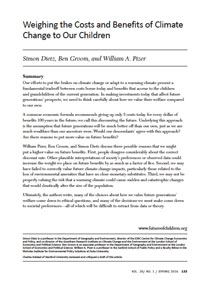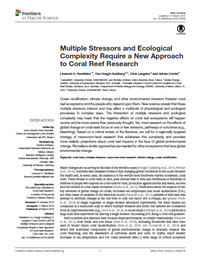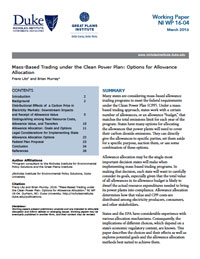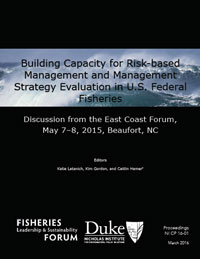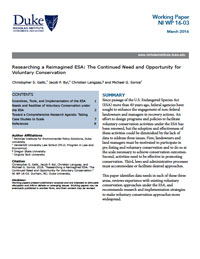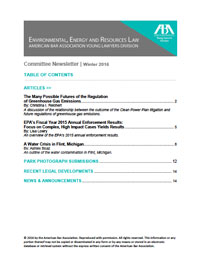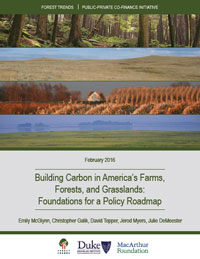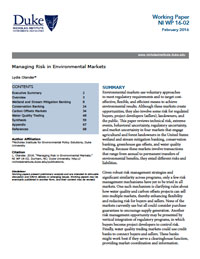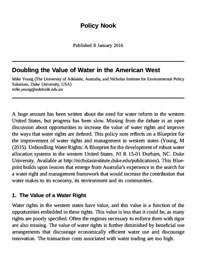Publications
Weighing the Costs and Benefits of Climate Change to Our Children
In making climate change mitigation or adaptation investments, we need to think about how we value the welfare of future generations compared to our own. Assuming that future generations will be better off than our own, just as we are better off than our ancestors, a common formula for “discounting the future” recommends paying only 5 cents today for every dollar of benefits 100 years from now. This article in the journal the Future of Children describes three reasons to put more value on future benefits. First, other interpretations of preferences or observed data could increase the weight we place on future benefits by as much as a factor of five. Second, future climate change impacts, particularly those related to the loss of environmental amenities that have no close monetary substitutes, could be undervalued. Third, the risk that a warming climate could cause sudden and catastrophic changes that would drastically alter the size of the population could be misunderstood. Ultimately, many choices about how we value future generations’ welfare come down to ethical questions, and many of the decisions we must make come down to societal preferences—and those choices and decisions will be difficult to extract from data or theory.
Multiple Stressors and Ecological Complexity Require a New Approach to Coral Reef Research
Ocean acidification, climate change, and other environmental stressors threaten coral reef ecosystems and the people who depend upon them. New science reveals that these multiple stressors interact and may affect a multitude of physiological and ecological processes in complex ways. The interaction of multiple stressors and ecological complexity may mean that the negative effects on coral reef ecosystems will happen sooner and be more severe than previously thought. Yet, most research on the effects of global change on coral reefs focus on one or few stressors, pathways or outcomes. In the journal Frontiers in Marine Science, authors call for a regionally targeted strategy of mesocosm-level research that addresses this complexity and provides more realistic projections about coral reef impacts in the face of global environmental change.
Mass-Based Trading under the Clean Power Plan: Options for Allowance Allocation
Many states are considering mass-based allowance trading programs to meet federal Clean Power Plan (CPP) requirements. Under a mass-based trading approach, states work with a certain number of allowances, or an allowance “budget,” that matches the total emissions limit for each year of the program. States have many options for distributing the allowances that power plants will need to cover their carbon dioxide emissions. They can directly give the allowances to specific parties, set them aside for a specific purpose, auction them, or use some combination of these options. Allowance distribution, more commonly known as “allocation,” may be the single-most important decision states will make when implementing mass-based trading programs. In making that decision, each state will want to carefully consider its goals, especially given that the total value of all allowances in its allowance budget is likely to dwarf the actual resource expenditures needed to bring its power plants into compliance. Allowance allocation determines how that value and CPP costs are distributed among electricity producers, consumers, and other stakeholders. States and the EPA have considerable experience with various allocation mechanisms. Consequently, the implications of different choices, which depend on a state’s economic regulatory context, are known. This paper describes the choices and their effects as well as explores potential goals and the allowance allocation methods best suited to achieve them.
Building Capacity for Risk-based Management and Management Strategy Evaluation in U.S. Federal Fisheries: Discussion from the East Coast Forum, May 7–8, 2015, Beaufort, NC
The 2015 East Coast Forum convened by the Fisheries Leadership & Sustainability Forum (Fisheries Forum) explored opportunities for federal fishery managers to support effective treatment of uncertainty and risk through risk-based management approaches and management strategy evaluation. The success of federal fishery management plans requires managers to communicate effectively about uncertainty and risk and to make decisions that perform well under conditions of uncertainty and environmental change. By understanding and accounting for limitations on the information that supports decision making, fishery managers can make decisions that are likely to meet management objectives and that reflect an explicit risk tolerance. The Fisheries Forum convenes a series of forums for council members, council staff, and NOAA Fisheries staff. Each forum focuses on a topic with regional and national relevance. The forums are a unique opportunity for managers to explore emerging issues and questions and to share ideas and information across management regions.
Researching a Reimagined ESA: The Continued Need and Opportunity for Voluntary Conservation
Since passage of the U.S. Endangered Species Act (ESA) more than 40 years ago, federal agencies have sought to enhance the engagement of non-federal landowners and managers in recovery actions. An effort to design programs and policies to facilitate voluntary conservation activities under the ESA has been renewed, but the adoption and effectiveness of these activities could be diminished by the lack of data to address three issues. First, landowners and land managers must be motivated to participate in pre-listing and voluntary conservation and to do so at the scale necessary to achieve conservation outcomes. Second, activities need to be effective in promoting conservation. Third, laws and administrative processes must accommodate or facilitate desired approaches. This working paper identifies data needs in each of these three areas, reviews experience with existing voluntary conservation approaches under the ESA, and recommends research and implementation strategies to make voluntary conservation approaches more widespread.
The Many Possible Futures of the Regulation of Greenhouse Gas Emissions
Some parties are saying that the unusual decision by the U.S. Supreme Court to delay an important greenhouse gas regulation does not bode well for the future of the rule. But how does the future of this particular regulation, the Clean Power Plan (CPP), affect the future of climate policy in general? This article focuses on how three possible outcomes of CPP litigation might affect future climate policy.
Incentivizing the Reduction of Pollution at Dairies: How to Address Additionality When Multiple Environmental Credit Payments Are Combined
Anaerobic digesters (ADs) can reduce waste volumes and capture methane emissions from concentrated animal feeding operations (CAFOs), but their adoption rate is low because their cost is high relative to other forms of waste management. Farmers who use ADs can attempt to sell carbon credits and nutrient credits as well as renewable electricity certificates (RECs) generated by on-site electricity production from captured methane. These credits and RECs can be used as marketable “offsets” that buyers can use to help meet their greenhouse gas and nutrient pollution reduction goals. One issue that arises is whether a single operation can sell into multiple credit markets by “stacking” credits—that is, receiving multiple environmental payments to finance the conversion to AD technology. This practice introduces the possibility that some credits might be “non-additional”—i.e., produce no incremental pollution reductions—and thus be suspect pollution offsets. Non-additionality in environmental credit stacking occurs when multiple payment streams do not produce incremental pollution reductions, thus allowing the credit buyer to pollute more than is being offset by the AD project. A possible solution to the stacking problem may be to allow stacking of all credits available at the time of AD installation, but to prohibit any further stacking if new credit streams become available after installation. This is a revised paper that was originally published in 2015.
Building Carbon in America’s Farms, Forests, and Grasslands: Foundations for a Policy Roadmap
In the United States, land carbon offsets nearly 15 percent of economy-wide greenhouse gas emissions, equivalent to half of emissions from the transportation sector. However, the future of this sizable "carbon sink" is uncertain. The latest U.S. assessments disagree on whether land will be a sink or a source in the coming decades, which could make all the difference in whether future climate targets are reached. Despite significant research, a complete understanding of policy or market tools capable of bending the trajectory of the carbon sink remains elusive. This report by Forest Trends and the Nicholas Institute for Environmental Policy Solutions—the first product of the Land Carbon Policy Roadmap Initiative—launches a process for understanding the most significant drivers of land carbon change and the policy tools critical for managing land carbon into the future. It offers new analysis to support a long-term roadmap for enhancing the U.S. land carbon sink, ensuring that healthy and productive landscapes contribute to greenhouse gas reduction goals.
Managing Risk in Environmental Markets
Environmental markets use voluntary approaches to meet regulatory requirements and to target cost-effective, flexible, and efficient means to achieve environmental results. Although these markets create opportunities, they also involve some risk for regulated buyers, project developers (sellers), landowners, and the public. This paper reviews five types of risk these actors face—technical risk, extreme events, behavioral uncertainty, regulatory uncertainty, and market uncertainty—in four markets that commonly engage agricultural and forest landowners in the United States—wetland and stream mitigation banking, conservation banking, greenhouse gas offsets, and water quality trading. These markets involve transactions that range from annual to permanent transfers of environmental benefits. Thus they entail different risks and liabilities. Given robust risk management strategies and significant similarity across programs there are but a few risk management mechanisms that have yet to be tried in all markets and that present opportunities for improvement. These mechanisms include clarifying rules about how water quality and carbon offsets projects can sell into multiple markets, thereby enhancing flexibility and reducing risk for buyers and sellers. None of the markets currently use but all could consider purchase guarantees to encourage supply generation. Another opportunity may be vertical integration of regulatory programs, in which buyers become project developers to control risk. Finally, water quality trading markets could use credit banks to connect buyers and sellers. These banks might work best if they serve a clearinghouse function, providing market coordination and information.
Doubling the Value of Water in the American West
Progress on water reform in the western United States has been slow. Little discussed are opportunities to increase the value of water rights and to improve the ways that they are defined. This policy note in Water Economics and Policy reflects on Unbundling Water Rights: A Blueprint for Development of Robust Water Allocation Systems in the Western United States, a Nicholas Institute report that builds on lessons from Australia’s search for a water rights and management framework that would increase the contribution that water makes to the economy, the environment, and communities.

